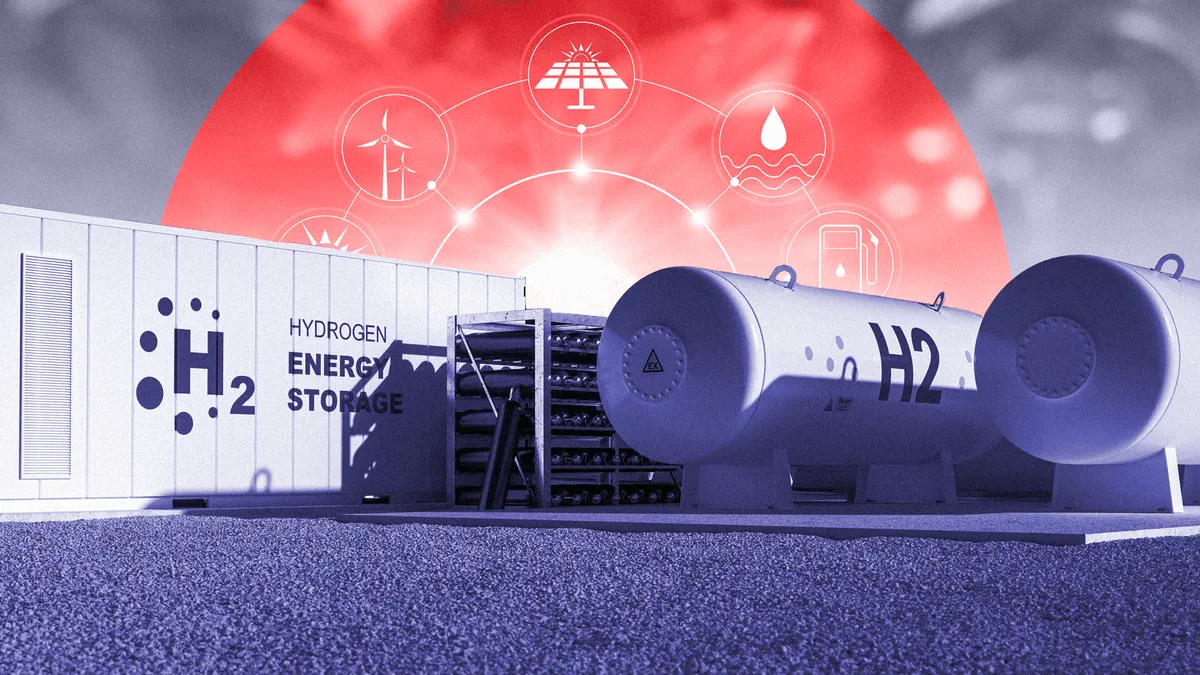Dive Brief:
-
A team led by the Gas Technology Institute (GTI) aims to draw up preliminary engineering designs for a system that would generate hydrogen, store it, and then return it to power production at times of peak demand.
-
The project, which has received $800,000 from the U.S. Department of Energy, is the second phase of an ongoing effort to demonstrate the use of hydrogen as a means of long-term energy storage. The final phase of the overall effort could see the installation of the storage system at a natural gas combined cycle power plant operated by Southern Company subsidiary Alabama Power.
-
The project will demonstrate an application of hydrogen that could reduce both the carbon intensity and cost of dispatchable energy generation, using largely existing technology and a novel hydrogen generation technology being tested by GTI, according to Don Stevenson, vice president of energy supply and conversion at GTI.
Dive Insight:
All-hydrogen power plants may still be some years out, but hydrogen could play a part in power generation much sooner if a study currently underway is successful.
A GTI-led team including Southern Company, Pacific Gas & Electric, and the Electric Power Research Institute have received $800,000 from the DOE to conduct a preliminary front end engineering design study — the second phase in an ongoing effort to explore converting an existing Southern Company natural gas plant in Alabama to produce, store, and run on hydrogen.
The plant won't operate on 100% pure hydrogen — at least not at first — because 100% hydrogen turbines are not yet available for gas power plants, Stevenson said. Instead, the project will focus on part of the plant that is already capable of using pure hydrogen: the duct firing burner.
GTI's team aims to use hydrogen, rather than natural gas, in the duct firing burner to quickly boost power production at times of high demand or when renewable power is not available. While the main turbines will still need natural gas, injecting hydrogen into the duct firing burner would eliminate emissions from that part of the plant while cutting electrical costs by 17-18% compared to alternatives with carbon capture technology, Stevenson said.
"Electricity markets seek the lowest-cost power available at the time the energy is needed," Stevenson said. "By offering a lower cost solution for low-carbon, dispatchable power this technology makes it more likely to be chosen for use first, resulting in lower overall emissions."
To achieve the cost reduction, the power plant itself will generate and store up to 54 MWh worth of hydrogen on site using a process GTI calls sorbent enhanced steam reforming. This process, currently the subject of two other pilot projects in the U.S. and the U.K., uses calcium oxide to absorb carbon dioxide in the same reactor used to split the gas into carbon and hydrogen, Stevenson explained. Converting natural gas into hydrogen on-site with sorbent enhanced steam reforming reduces overall carbon emissions by 98% and eliminates the need to add a more expensive carbon capture system to the back-end of the power production process, Stevenson said.
Stevenson said he anticipates the preliminary front end engineering design will be completed by the first quarter of 2023, and that if everything progresses smoothly an actual hydrogen generation and storage system could be operational at an Alabama power plant by 2025 or 2026 — this compared to waiting for turbine technologies that Stevenson estimated won’t be available for the next seven to 10 years.
"The end objective is to get to 100% hydrogen-fired turbines," Stevenson said. "This is a good step along this path, and it’s something that we can do now, at an existing power plant."
Clarification: A previous headline referred to DOE funding for the conversion of the gas plant. The funding covers a preliminary analysis that could lead to the conversion of an Alabama plant to run partially on hydrogen.













